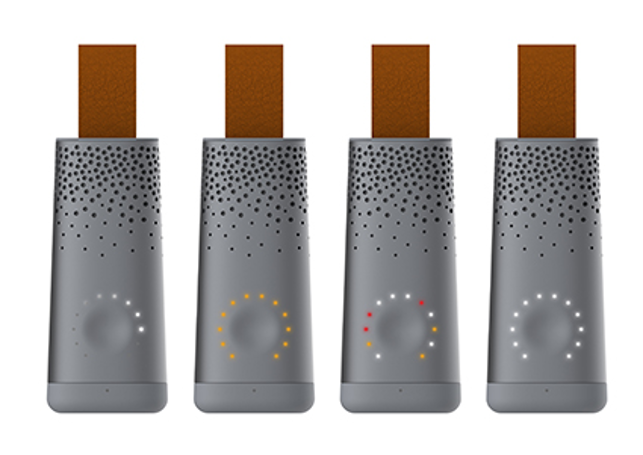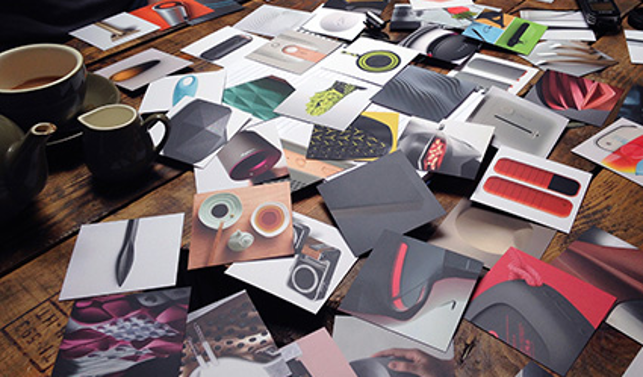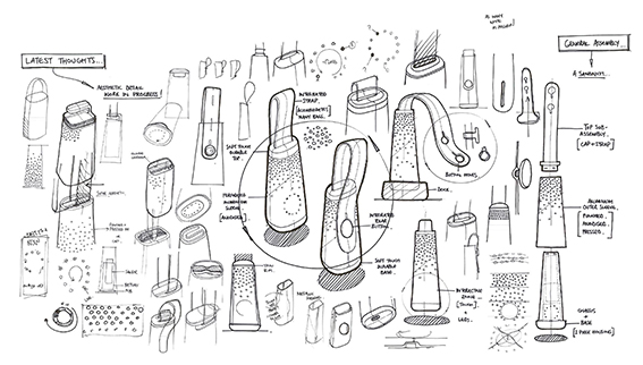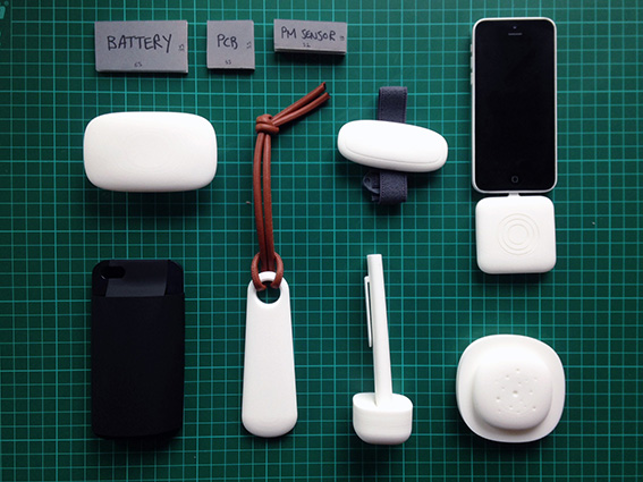
A Keyshot rendering of the Flow air quality tracker showing how it can be easily worn on a back pack
We breathe in 20kg of air every day and because we can’t see it, we don’t know what’s in it. Those living in cities especially are breathing in a toxic cocktail that could have a detrimental effect on their health.
The statistics for air pollution are quite literally breath taking. Take London for instance. The city breached its EU limits for annual air pollution within the first five days of 2017, according to the London Air Quality Network at King’s College London.
But it’s not just major cities; in a report issued in September 2016, the World Health Organisation estimated that 92 per cent of the world’s population now lives in areas that exceed safe levels of particulates – those tiny particles or droplets such as dust, soot and carbon that get lodged deep in our lungs.
In order to make air more transparent, Romain Lacombe and David Lissmyr founded Paris-based technology company Plume Labs in 2014. Its mission is to provide users with the tools to help them breathe better by informing them of what’s in the air around them.
“Air pollution is a leading avoidable cause of death worldwide. The consumer tech industry has the tools – and the moral obligation – to take a leadership role in tackling this crisis,” says Lacombe.
Having assembled a team of engineers, developers, researchers, and strategists and following 2.5 years of hard work, Plume Labs unveiled the Flow air quality tracker in January 2017.
The device essentially sucks air into its 360-degree valve. Sensors inside then scan this air for particulate matter, nitrogen dioxide, ozone, volatile organic compounds (VOCs), temperature and relative humidity. By pressing its soft touch component, the user can then see how ‘fresh’ to how ‘extremely polluted’ the air is via 12 LED lights (the more polluted the air, the more red the lights are) or view a 12 hour historical exposure set.
All this feedback is mirrored in the companion smartphone app that also provides more in depth exposure reports and predicted air pollution forecasts sourced from Plume Labs’ Artificial Intelligence (AI) platform, helping users decide when the best time is to head outdoors.
“What we are trying to do is give individuals a much better personal understanding of their own exposure to air pollution so that they can start taking steps to avoid over exposing themselves. And, of course, whilst it makes their own environmental health more personal, the crowdsourcing of air quality in the city from a number of these devices will enable us to create a live air map so that others can find fresh air too,” explains Lacombe.

Flow features glanceable real-time and historical air quality exposure feedback via 12 multi-colour LEDs and capacitive touch button
Flagship product
In 2015 Plume Labs launched its flagship smartphone app – Plume Air Report – which provides real-time air quality level forecasts in more than 60 countries by drawing on data from 11,000 sensors located on air stations across 279 cities.
However, the intention was always to a provide the user with their own air pollution sensor. But developing the sensing technology and environmental AI was no mean feat and so Plume Labs has partnered with scientists and researchers from the likes of CNRS-LISA (a mixed research laboratory in Paris) and Imperial College London.
“The amazing lab at CNRS-LISA specialises in simulating atmosphere and has all these instruments to make any sort of pollution you want. So that really helped in developing and testing our technology,” comments Lacombe.
Having developed its solution and with a $4.5 million boost in seed round funding, Plume Labs approached global design and strategy firm frog to help it create a device in which to package this technology and also support a goto-market strategy.
“We had already tried to come up with an industrial design for a device ourselves and had gone quite far down this path having created a number of prototypes but we realised we were going nowhere,” confesses Lacombe.
“We hadn’t found the right balance between how to design a personal consumer product that can work out of the box, is easy to use and can be worn in all sorts of different contexts but yet is also discreet. The device also had to carry that sense of being a serious product with a strong technical reliability and accuracy but at the same time it had to be desirable. So there was a huge design challenge and that is why we reached out to frog.”

The intense six week design process kicked off with brainstorming and gaining inspiration through other products, materials and industries
Short but focussed design process
The design process was to take place over six weeks during June and July 2016. To achieve what Plume Labs wanted to in such a short timeframe, the decision was taken to have both teams work side by side in frog’s London office.
“From my understanding this is actually quite rare and we have been very lucky to work the way we did – being completely embedded with the frog team for the entire duration of the project,” says Lacombe.
Tom Peach, frog’s lead industrial designer on this project, adds, “Having the two teams side by side every day, often for very long periods, was absolutely vital to our collaboration and success of the project.
“We were able to quickly iterate between engineering, design and research, staying aligned to brand strategy and company vision. We could work details instantaneously, navigate any challenges seamlessly across disciplines and keep the ship aligned in the same direction.”
The six weeks were broken down into three parts with the first two weeks dedicated to research and concept design.
This involved a lot of planning, brainstorming, sketching, rapid prototyping and then user research validation. As Peach says, frog’s aim is to humanise technology through a focus on user-centered design.
“We are always trying to take explorations that clients have done, in this case it was all the technical workings and the proof of concept, and then try to define where the value lies for people – to provide a humanised version of their technology,” he explains.

This quickly moved onto exploration through sketching
Determined not to create another wearable in the form of a wristband, the team aimed to differentiate the product and through user research determined the shapes, colours, materials and finishes that users preferred as well as trying to understand where they could actually imagine themselves using this device, for instance attached to a backpack whilst commuting or on the handle of a baby stroller when out walking.
A key aspect of the collaboration was the close working relationship between frog’s creative team and Plume Lab’s mechanical and electronic engineers to define an internal component layout in line with the design intentions, and this was taking place almost instantly from concept stage.
“We collaborated with Plume Lab’s engineers very early on in the process to explore directions that were not only desirable for the user but also, importantly, viable and feasible, given the constraints they knew they could work with,” says Peach.
“Very often in design, mechanical engineers are brought into a project too late, almost after the design has happened, but here we collaborated as early as possible to build belief and strength in what we were doing. That was one of the most interesting parts of this project.”

A key to the success of this project was the on-site collaboration between Plume Labs and frog design
Mid way point
The following two weeks were dedicated to design development in which a selection of lead directions were further developed in SolidWorks.
The data was then sent to local London 3D printing houses who would courier back the 3D prints as soon as possible for usability checks before being sent into the field for testing with users.
“We then came back as a design team to assess the latest insights from user research and begin to really balance as many things as possible with mechanical engineering, electronics engineering, their brand identity as a company.”
The last two weeks of the project were dedicated to the refinement of the chosen design proposal, which was a sleek yet robust product that featured a brushed aluminium metallic body with soft touch components together with a leather strap. From both rounds of research, it was felt that this design creates a statement that users would be proud to own and believe in, whether attached to a bag when on the move or standing proud in the home or office environment.
Frog also helped in creating marketing materials for Flow. Without a final aesthetic prototype that could be photographed, frog rendered the device in Keyshot and then Photoshopped it onto professional photographs to provide more context and belief in the design.
“You don’t see much of this really. Typically a product is visualised on white or a coloured background but we are beginning to see this trend in the design industry in using context imagery to add more realism. Actually, it’s quite an old technique from the 1980s and 1990s that is beginning to come back. It really helps to convey the narrative of the product and helped Plume Labs to picture their device in use,” describes Peach.
Lastly, frog also provided a six to eight month road map that included what needed to be done before developing pre-production prototypes and then the various manufacturing routes available, together with shipping and assembly options.
“What we ultimately try to do is set our clients up in the best possible position – to give them something that not only addresses aesthetics and usability, but also has got ‘legs’ to last during the development cycle, through to industrialisation as seamlessly as possible,” says Peach.

Exploring what a wearable air pollution tracker could be through the use of 3D printing
Tech for a better world
From Lacombe’s point of view this “intense and focused collaboration period” was a success and enabled Plume Labs to unveil Flow at the Consumer Electronics Show (CES) in Las Vegas earlier this year. It was even named as a CES 2017 Innovation Awards Honouree in the ‘Tech for a Better World’ category.
“This is very encouraging, especially as a young company. It not only means that we are on the right track with this product but also industry at large recognises that this is an issue that hasn’t been addressed yet,” comments Lacombe.
Before Flow’s official launch in the summer, Plume Labs has had a small batch of 100 prototypes produced for a beta test that is currently taking place with users in London.
“The reason why the beta is important is because it helps us make sure we iron out not only the technological aspect of things – the entire software back end has to work as well as the mapping system – but also the experience people have when using the device,” states Lacombe.
When it is launched, although those Flow users will be more aware of what’s in the air they breathe and can take steps to limit their exposure by changing routines, it won’t necessarily stop pollution. But, as Lacombe says, fighting air pollution is a long journey and we’re just getting started. 
Plume Labs collaborates with frog design to create a wearable air pollution tracker
Default






